#lancelet
Text

Lancelet
Illustration for the new edition of "The Mists of Avalon"
Nimue Morgaine & Mordred
Twitter | VK | INPRNT | Leave a tip
1K notes
·
View notes
Text
The modern world is nice, but sometimes you just get the urge to go primitive. Because I'm a complete wimp who would die within a day of giving up the internet, I'm going to deal with that urge by talking about primitive animals. It's Wet Beast Wednesday and I'm talking about lancelets.

(image: a lancelet. Not much to look at, are they?)
Lancelets, or amphioxi, are highly basal (close to the ancestral form) chordates that are vaguely similar to fish, but are vastly more primitive. They have all the characteristics of chordates, the key one being a notochord, a flexible rodlike structure that goes down the body. The majority of chordates that are still alive are vertebrates, who have incorporated the notochord into the spinal column. The other groups of surviving chordates are the tunicates (who I'll get to eventually) and the lancelets. Because lancelets are so primitive, they are used at model organisms representing an early stage of vertebrate evolution. It was originally thought that lancelets are remnants of an early lineage that eventually evolved into vertebrates. Genetic studies later showed that tunicates are actually more closely related to modern vertebrates than lancelets. They are still used as a model organism as they are a fantastic representation of early chordates. The similarity of lancelets to the 530 million year old Pikaia gracilens, one of the earliest known chordates, is one of the reasons they are such a useful model organism.

(image: a diagram of lancelet anatomy by Wikipedia user Systematicist)
Lancelets can be found all over the world, living in temperate to tropical shallow seas. The only known exception is Asymmetron inferum, which has been found around whale falls at 225 m (738 ft) deep. They are small animals, reaching around 8 cm at their largest. An amphioxus looks pretty worm-like, with a simple mouth at one end and a pointed tail at the other. The name amphioxus means "both (ends) pointed" which is a pretty appropriate description. The mouth is lined with tentacle-like threads called oral cilli, which are used for feeding. Lancelets are filter-feeders that use the cirri to filter plankton, microbes, and organic detritus. Water and food pass into the pharynx (back of the mouth), which is line with gill slits. This is where it gets weird. The gill slits aren't used for respiration, but for feeding. Mucus gets pushed through the gill slits by cilia, trapping the food and moving it deeper into the digestive tract. Not only to lancelets not use their gill slits to respirate, they actually don't have a respiratory system at all. Instead, they just absorb dissolved oxygen through their thin and simple layer of skin. Their circulatory system doesn't move oxygen around either as there is no heart or hemoglobin present. For what it's worth, they don't have a proper live either. When you look at a lancelet's anatomy, you can see similarities to fish anatomy, just much more primitive and with some parts missing.
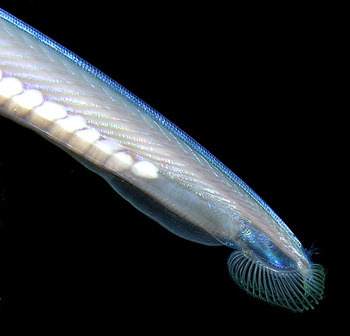
(image: the head of a lancelet, with mouth and cilli visible)
Lancelets have 4 different systems used for vision. Two, the Joseph cells and Hesse organs, are simple photoreceptors that are on the notochord and detect light along the back of the animal. Imagine having a bunch of very simple yes on your spinal cord that can see through your skin. There is also a simple photoreceptor called the lamellar body (which confusingly is also the name of a type of lipid) and a single simple eye on the head. Speaking of light, lancelets are florescent, producing green light when exposed to blue to ultraviolet light. In all species, the proteins responsible for this are found around the cilii and eye, but some species also have them in the gonads and tail. The purpose for this florescence isn't exactly known, but a common hypothesis is that it helps attract plankton toward their mouths.
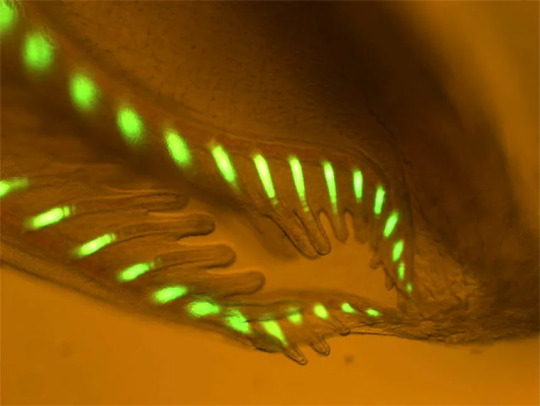
(image: an extreme close-up of a lancelet's cilli fluorescing)
Lancelets have seasonal reproduction cycles that occur in summer. Females release their eggs first, followed my males releasing sperm to fertilize them. Depending on species, spawning can either occur at specific times, or gradually throughout breeding season. Development occurs in several stages. In the frist stage, they live in the substrate, but they will quickly move into the water column to become swimmers. These swimming larvae practice diel vertical migration, traveling to the surface at night and returning to the seafloor in the day. While larvae can swim, they are still subject to the current and can be carried long distances. Adults retain their ability to swim, which is done by wriggling like an eel and in some cases, spinning around in a spiral fashion while moving forward. Unlike the larvae, adults spend most of their time buried in the substrate with only their heads exposed. They typically only emerge when mating or if disturbed.
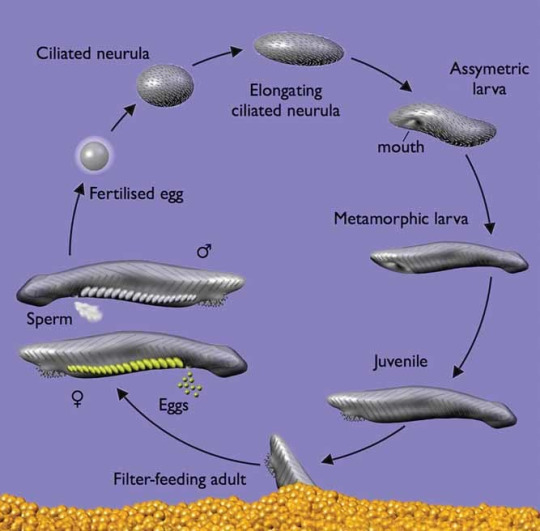
(image: a diagram of the lancelet life cycle. source)
Because of their use as model organisms, humans have developed methods to keep and breed lancelets in captivity. The majority of research has been done on Branchiostoma lanceolatum, but several other species have been studied. Multiple species are endangered due to pollution and global warming. Several species are edible and can either be eaten whole or used as a food additive. In spring, when their gonads begin to develop for breeding season, they develop a bad flavor.
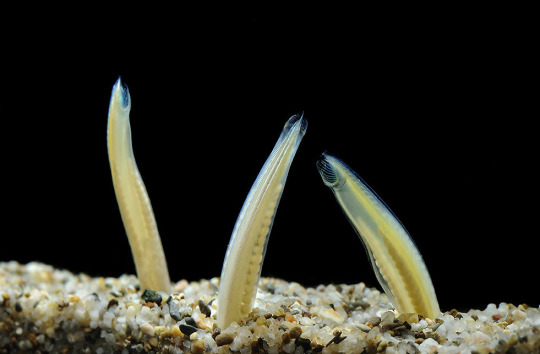
Mom: "we have garden eels at home". Garden eels at home:
(image: three lancelets sticking their heads out of the sediment)
#wet beast wednesday#weird-ass tube beast#lancelet#amphioxus#chordate#chordata#marine biology#biology#ecology#zoology#animal facts#evolutionary biology
234 notes
·
View notes
Text
Phylum #8: Chordata!



A notochord under a hollow nerve cord, pharyngeal slits and a post-anal tail. United by a simple but elegant body plan, chordates nonetheless became one of the most diverse phyla in the animal kindom. While the small filter-feeding lancelets closely preserved the original chordate body plan, tunicates and vertebrates would reshape it in unexpected ways, with new materials gained through evolution.
Tunicates achieved the unique ability among animals to synthesize cellulose. Tadpole-like larvaceans build submarine-like "houses" with complex sets of filters to collect food particles. Other tunicates, after a drastic metamorphosis, abandon the notochord and fully integrate cellulose tunics as their body walls, often merging them together in massive colonies.
Meanwhile, vertebrates built upon the original notochord, housing it in a solid skeleton of cartilage or bone. With this, vertebrates could not only reach land, but even conquer the skies, with three out of the four flying clades in animal history being vertebrates (birds, bats and pterosaurs).
Their internal skeleton providing both support and flexibility, vertebrates have dominated megafauna for more than 300 million years. Especially on land, they brought animal life to scales previously unheard of: at 70 tons, Argentinosaurus weighed 200 times as much as the largest invertebrate to ever walk land, Hibbertopterus.


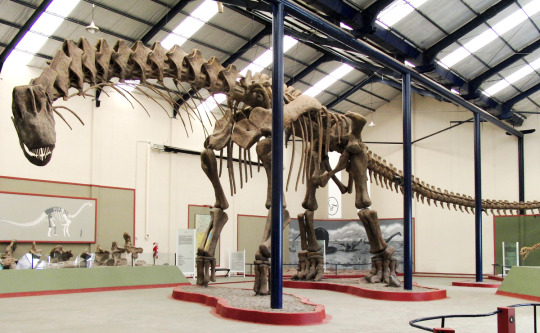
144 notes
·
View notes
Text
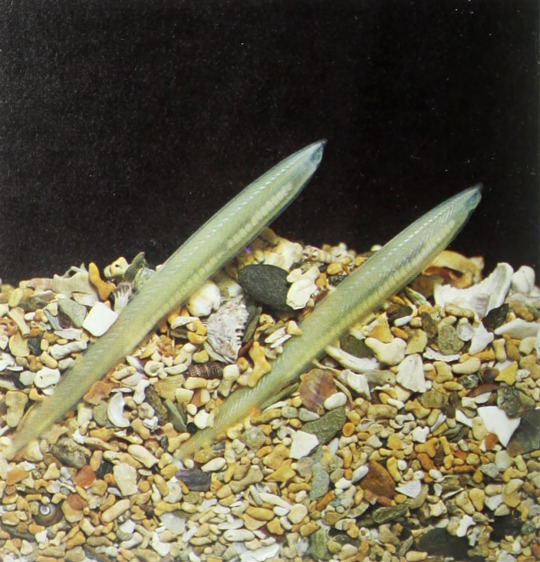
Lancelets (Branchiostoma sp.)
By: Heather Angel
From: The Complete Encyclopedia of the Animal World
1980
38 notes
·
View notes
Text
Lancelets diversity.

1. Shrimp analog. Fastening with its jawlegs to the sea bottom, it scrapes algae (and only to) with its tonguelegs.
2. Salmon-like lancelet. Like a shark, it patrols the bottom of river and lakes in search of food. It can both filter water and catch bottom animals.
3. Long carnivore lancelet, who lives in sand.
4. Filter feeding lancelet.
#art#inkart#sketch#speculative biology#inkdrawing#speculative zoology#biology#speculative#evolution#lancelet#creature
15 notes
·
View notes
Text

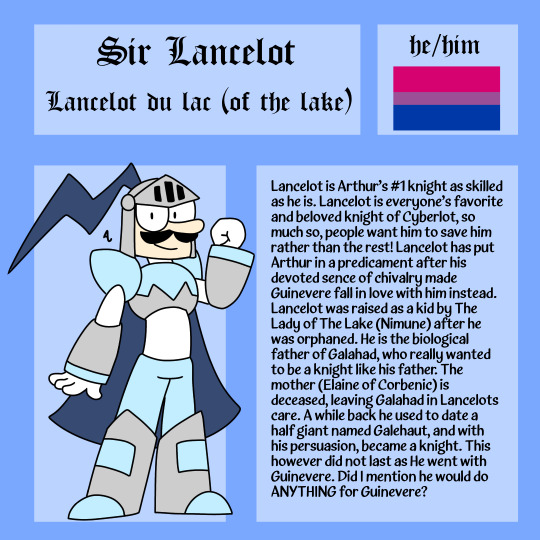

LANCELOT THE SILLIEST KNIGHT AROUND
ALSO THE ONE THAT REALLY LIKES GUINEVERE LIKE-
this post is deticated to @reallancelotfan01 😎
#arthur king of cyberlot#arthurian legend#knight#knights#art#myart#ref#character design#cyber knights#arthur#king arthur#lancelot#lancelet#sir lancelot#sir lancelet#lancelot du lac#sir lancelot du lac
6 notes
·
View notes
Text

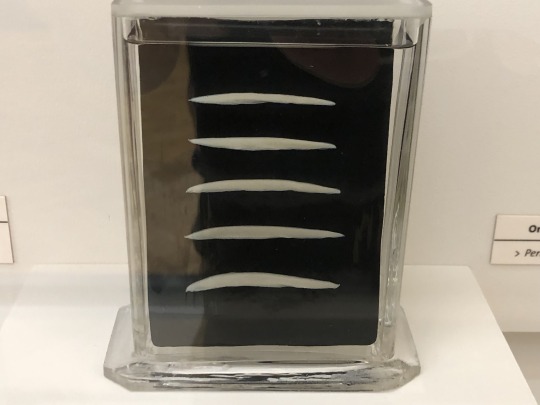
The strange creatures in these jars are relatives of ours! They're chordates, which means they share our basic body plan with a spinal chord running the length of the body. Unlike us, fish, reptiles, and all other vertebrates, however, they don't have any bones. The ones in the bottom picture are lancelets, and they look exactly how you'd expect from that description: little featureless fish/tadpole creatures. The tunicates in the top picture, however, took a very different path than the rest of us chordates: the adults are sessile filter-feeding bags. Their larvae, however, swim around and look a lot like the lancelets before they find a good spot to anchor themselves and change into their adult form.
4 notes
·
View notes
Text
hello tumblr can you show me the funny posts
0 notes
Text
i don’t know how to ask this in a way that doesn’t make me sound like a tool so i’m just gonna ask:
why is oberon’s ascension unlock fight considered so difficult? nothing raised big red flags when i was reading about it, and i 3 turned it in one attempt with my moriarty which made me disappointed with how easy it felt so i never uploaded it. i don’t not believe you all i just feel like i’m missing something.
#switch speaks#there have been a handful of ‘felt too easy’ esports casualties for me the past year#barg and lancelet were others#fate//
5 notes
·
View notes
Text
"The tale of two new kings" - [Intro. post⚔️🛡️]
[All OOC (out of character) posts and tags will be made in brackets like this one. All basic DNI rules. Anons allowed; if your rude or spam you will be blocked]
[Hello! My name is Deerly and my main blog is @deerdeardarling where I mainly post about my Pokemon Chosen AU, which this blog is apart of! As well as all of my other hcs & aus. This blog is specifically around my version of The First Two Galarian Kings! who were only crowned a year ago.]

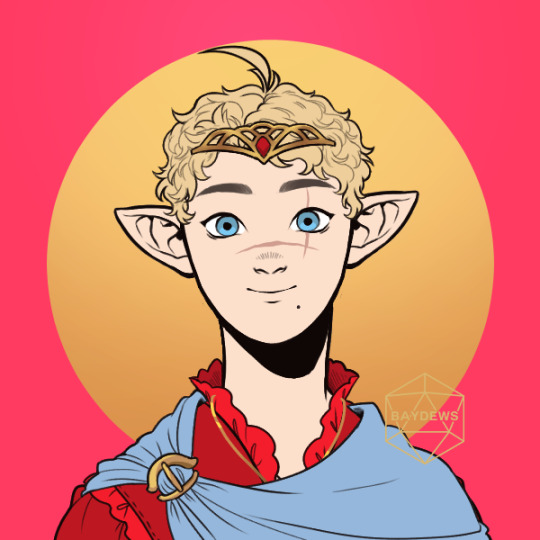
[These two are Tarax (right) and Lancelet (left)! They are the original Chosens of Zacian and Zamazenta and are around 16 years old. Tarax is very spry and tries to be uplifting and positive even in times of uncertainty; while Lancelet (or just Lance) is more reserved and quick witted (this. will very likely not show well in my writing. cause i am not smart lmao)]
[Note: I'm gonna try to use like. ye olde speak but really no guarantees. Really this is all just for fun and so I can share my ideas. Also blog lore will be in another post after this one initial one]
#pokemon rp#pokemon irl#[i guess?]#pokeblogging#pokemon sword and shield#pkmn swsh#[what else do i tag this???]#King Tarax#King Lancelet
7 notes
·
View notes
Text
i wish we had more chordates that retained chordate synapomorphies into adulthood :(
#pant rambles#i think it's awesome that lancelets do#but i need More creechur (<- wants to Make creechur)#edit: okay lampreys retain them too but STILL. i want limbed creechur...
2 notes
·
View notes
Text
Battle teams and leasure teams for Tarax & Lancelet!

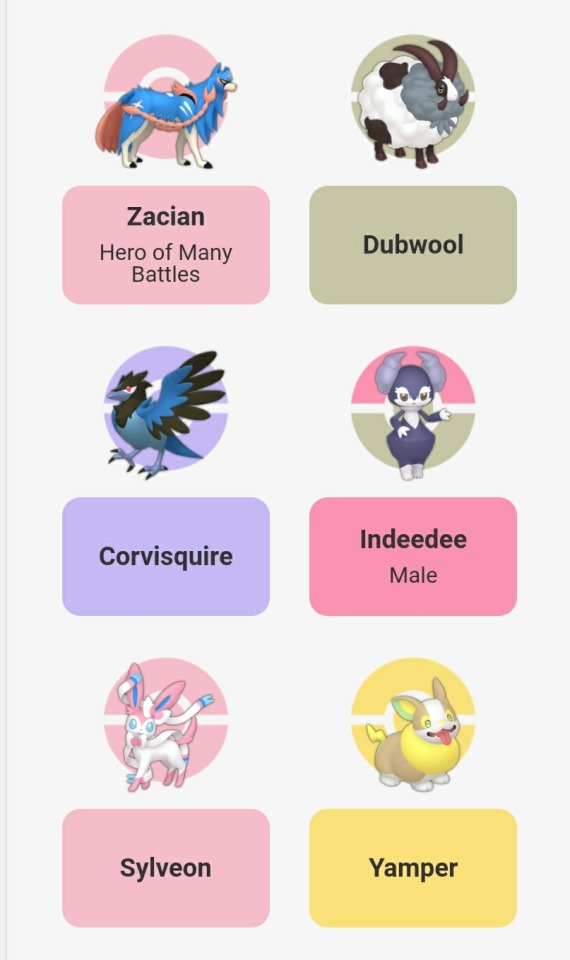


Socialite vs Bookworm lol
1 note
·
View note
Text

Immature lancelet
By: Unknown photographer
From: Natural History of Marine Animals
1949
27 notes
·
View notes
Text
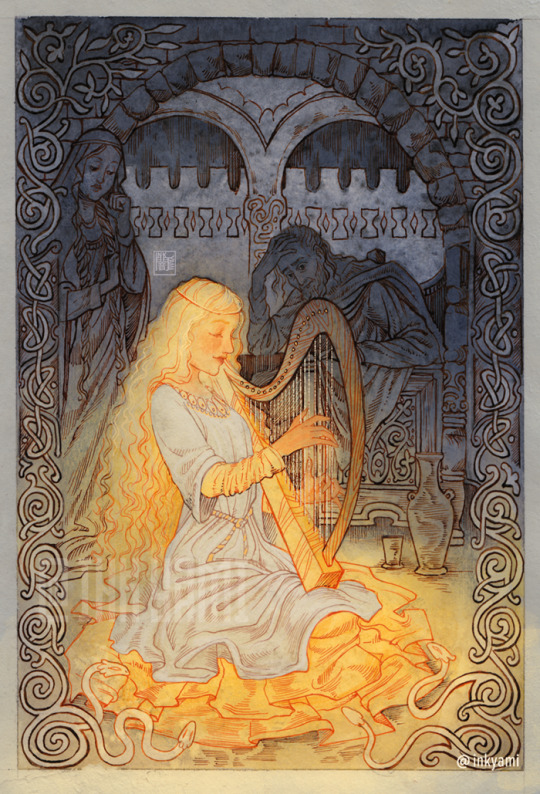

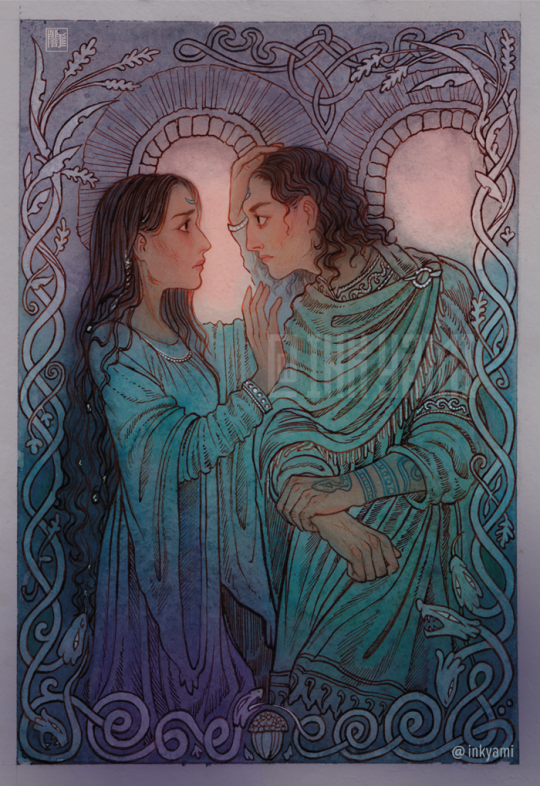

Illustration for the new edition of "The Mists of Avalon"
Nimue Lancelet Morgaine & Mordred
Twitter | VK | INPRNT | Leave a tip
759 notes
·
View notes
Text
hey check this shit out

the lancelet ☝️
956 notes
·
View notes
Text
What Is and Isn't a Fish: a List
A list of the animals I discussed in my fish essay, but for those who don't want to scroll through paragraphs of text to find out if an animal is or isn't a fish. Just CTRL+F your way through here!
I'll add onto here more animals whenever I get asked about them being fish. See my fish essay here!
Some notes before you proceed:
Yes, all tetrapods are fish! We are phylogenetically fish, as we are and our ancestors were lobe-finned fish! "Fish" in the phylogenetic sense is a paraphyletic group if you try to exclude tetrapods, so it is frankly impossible.
How come tetrapods aren't listed as fish then? Long answer, read my essay. Short answer, me and other fish accounts tend to operate on the morphological definition of fish, so does most of the world. Here I use the morphological definition of "fish".
Fish:
Jawless fish
Hagfish
Lamprey
Cartilaginous fish
Sharks
Dogfish
Whale shark
Chimaeras/Chimeras/Ghost sharks
Ratfish
Ray
Stingray
Skate
Ray-finned fish
Teleosts
Catfish
Eels
Moray eel
Seahorse
Sea dragon
Lobe-finned fish
Coelacanth
Lungfish
Not Fish:
Crustaceans
Krill
Shrimp
Crab
Crayfish/Crawfish/Crawdad
Lobster
Spiny lobster
Triops
Mantis shrimp
Barnacle
Isopod
Copepod
Shellfish
Mollusks/Molluscs
Gastropods
Sea snail
Sea slug
Snails and slugs in general
Sea angel
Sea hare
Sea bunny
Cephalopods
Octopus
Squid
Cuttlefish
Nautilus
Inkfish
Bivalves
Clam
Mussel
Scallop
Oyster
Chiton
Chelicerates
Horseshoe crab
Sea spider
Water mite
Diving bell spider
Cnidarians
Jellyfish/Sea jelly/Jelly
Coral
Sea anemone/Anemone
Siphonophores
Portugese man o' war
Echinoderms
Sea cucumber
Sea pig
Feather star
Sand dollar
Sea biscuit
Sea cookie
Brittle star/Serpent star
Sea urchin
Starfish/Sea star
Comb jelly
Lancelet
Tunicates
Sea squirt
Salp
Annelids
Bristle worm
Bobbit worm
Spoon worm
Giant tube worm
Bone-eating worm
Sea mouse/Sea mice
Feather duster worm
Christmas tree worm
Leech
Flatworm
Amphibians
Salamander
Amphiuma
Mudpuppy/Mud puppy
Waterdog
Olm
Axolotl
Siren
Frog
Toad
Tadpole
Caecilian
Reptiles
Sea snake
Water snake
Snakes in general
Sea krait
Turtle
Snapping turtle
Softshell turtle
Sea turtle
Terrapin
Marine iguana
Crocodilian
Crocodile
Alligator
Caiman
Gharial
Bird
Penguin
Seagull
Loon
Swan
Mammals
Whale
Orca
Baleen whale
Toothed whale
Dolphin
River dolphin
Porpoise
Narwhal
Beluga whale
Sperm whale
Pinniped
Seal
Sea lion
Leopard seal
Elephant seal
Walrus
Sirenian
Manatee
Sea cow
Dugong
Otter
Sea otter
Beaver
Hippo
Platypus
Muskrat
Water shrew
323 notes
·
View notes